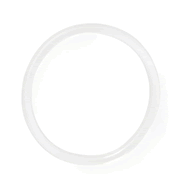Birth control ring

The birth control ring (brand names: Annovera and NuvaRing) is a small, bendable plastic ring that you insert into your vagina. You leave it in place for three weeks at a time, then take it out for the fourth week. The main way the ring works is by giving off hormones that prevent your ovaries from releasing eggs.
There are two types of birth control rings, one that you can use over and over for up to a year (Annovera) and one type that is replaced monthly (NuvaRing or its generic versions).
Types of Rings
Annovera is a white, bendable birth control ring that you can use for up to a year. You insert it into your vagina and keep it there for three weeks. At the end of the third week, you take it out, wash it with mild soap and water, pat it dry, and store it in its case at room temperature for a week. That’s usually when you get a withdrawal bleed, which is similar to a period. At the end of the fourth week, you put it back in your vagina and start the whole cycle again. After 13 cycles, it’s time for a new Annovera.
Annovera contains two different kinds of hormones, estrogen and progestin, that work together to prevent pregnancy. These hormones are absorbed through the vagina. The main way they prevent pregnancy is by stopping ovulation from happening, which means that the ovaries don’t release an egg.
The monthly birth control ring (NuvaRing and its generic versions) is a clear, bendable birth control ring that you insert into your vagina. You leave NuvaRing in place for three weeks at a time, then take it out for the fourth week. That’s usually when you get your period. At the end of the fourth week, you insert a new ring.
NuvaRing contains two different kinds of hormones, estrogen and progestin, that work together to prevent pregnancy. These hormones are absorbed through the vagina. The main way they prevent pregnancy is by stopping ovulation from happening, which means that the ovaries don’t release an egg. Generic versions of NuvaRing contain the same hormones and work in the same way.
Details
Costs
How to Use It
Both types of rings are pretty easy to use. All you really need to remember is the schedule for inserting and removing the ring—and we can help you with that.
You may want to try the "twist" method, which involves twisting the ring. #### Annovera Once you insert the ring (see instructions below), leave it in for three weeks (21 days). Take it out for the fourth week (that means that you’ll leave it out for seven days). After taking it out, wash it with mild soap and water, pat it dry, and store it in its case at room temperature. When the ring is out, you’ll probably get a withdrawal bleed, which is like a period. After seven days, even if you’re still bleeding, put the Annovera back in again. If you leave it out for more than seven days, you’ll need to use a backup method of birth control, like condoms, for seven days after putting it back in. During the three weeks (21 days) that you have the ring in, it’s important not to take it out. And it’s designed to keep it in during sex. But if it ever comes out, make sure to put it back in right away. If the ring is out of your vagina for more than two hours total during those 21 days, you will need to use a backup method of birth control for seven days after putting it back in. __Here's how to put Annovera in__:__Step one__: wash your hands.
__Step two__: squish the ring between your thumb and index finger.
__Step three__: insert it into your vagina as far up as you can get it with your finger. It’ll sit tucked up against the side of your vaginal wall. The exact position doesn’t affect how well it works to prevent pregnancy, as long as the entire ring is inside your vagina. So you just want to make sure you’re comfortable and no part of it is coming out of your vagina. If you need to, you can take it out and try again or try just pushing it further into your vagina.
__Here’s how to take the Annovera out__:
__Step one__: wash your hands.
__Step two__: insert your finger into your vagina until you feel the edge of the ring.
__Step three__: hook your finger on edge of the ring and pull down.
Here’s [a video](https://www.annovera.com/how-to-use) showing how to put in and take out the Annovera. ####NuvaRing Just like with Annovera, once you insert the ring (see instructions below), leave it in for three weeks (21 days). Take it out for the fourth week (that means that you’ll leave it out for seven days). After taking it out, put it back in the re-sealable pouch it came in and toss it in the trash. Disposing of it in its pouch will help prevent the hormones in the ring from leaching into the environment. When the ring is out, you’ll probably get a withdrawal bleed, which is like a period. After seven days, even if you’re still bleeding, insert a new ring and start the cycle again. If you take the NuvaRing out during the three weeks (21 days) that you have the ring in, make sure to put it back in as soon as possible. If it’s out for more than 48 hours, you’re at risk for getting pregnant, and you’ll need to use a backup form of birth control for 7 days after putting the ring back in. If you leave the NuvaRing out for more than 48 hours during the third week of a cycle, put it back in right away. On the day when you would normally have taken the ring out (day 22 of the cycle, where day 1 is the day you put it in), take it out and put a new one in, skipping your ring-free week. If you don’t put a new one in on that day, you’ll need to use a backup form of birth control until you’ve had a ring in for 7 days in a row. __Here’s how to put the NuvaRing in__:
__Step one__: wash your hands.
__Step two__: squish the ring between your thumb and index finger.
__Step three__: insert it into your vagina as far up as you can get it with your finger. It’ll sit tucked up against the side of your vaginal wall. The exact position doesn’t affect how well it works to prevent pregnancy, as long as the entire ring is inside your vagina. So you just want to make sure you’re comfortable and no part of it is coming out of your vagina. If you need to, you can take it out and try again or try just pushing it further into your vagina.
__Here’s how to take the NuvaRing out__:
__Step one__: wash your hands.
__Step two__: insert your finger into your vagina until you feel the edge of the ring.
__Step three__: Hook your finger on the edge of the ring and pull down.
Side Effects
There are positive and negative things to say about each and every method. And everyone's different—so what you experience may not be the same as what your friend experiences.

